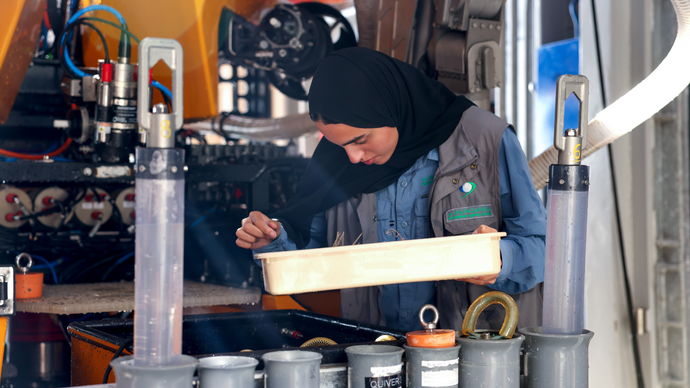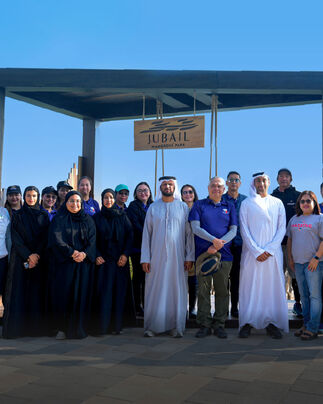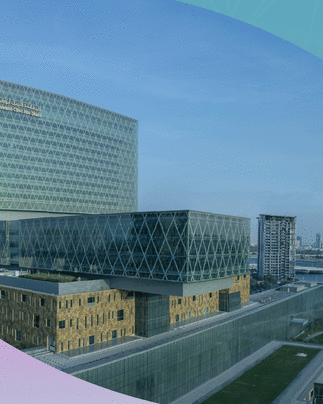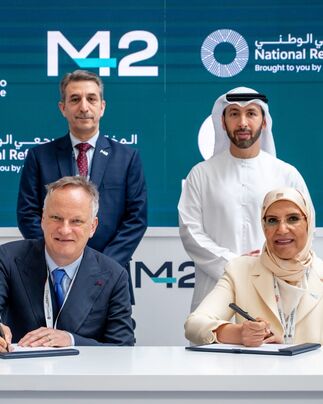The Environment Agency – Abu Dhabi (EAD) has completed a joint exploration mission in the Arabian Gulf as part of a multilateral agreement with M42 Healthcare, Bayanat, and OceanX to explore the impacts of climate change on UAE waters.
Over the course of a 20-day expedition aboard the OceanXplorer, an advanced research vessel, the team conducted joint research into environmental DNA (eDNA), analysed underwater microbial communities, evaluated nutrient concentrations, studied populations of large marine species, and surveyed the geology and bathymetry of the seafloor around the UAE.
During the expedition, 10 submersible trips were conducted, including the first submersible excursion undertaken by two female Emirati scientists from EAD. The research expedition included 19 dives using remotely operated vehicles (ROVs), collected 926 samples of marine water, biodiversity, and sediment, and supported 9 different studies from the EAD’s Abu Dhabi Environment Research Network in the UAE, a research network launched by the agency to enhance environmental research in Abu Dhabi. Scientists involved in this mission included four Emirati scientists engaging in research on deep-sea biology, geology and oceanography around the Arabian Gulf and Gulf of Oman. In addition, onboard were scientists from five entities of Abu Dhabi Environmental Research Network (ADERN).
A total of 13 DNA samples were extracted from seven different whale and dolphin species. The genomes of the Indo-Pacific bottlenose dolphin, Indo-Pacific finless porpoise, and Indian Ocean humpback dolphin were also fully sequenced.
A 773-nautical mile aerial survey was also conducted, during which 12 sightings of various megafauna were recorded, including bottlenose dolphins, spinner dolphins, sea turtles, hammerhead sharks and manta rays. The first observation of an endangered bramble shark in the UAE was made at a depth of about 850 metres.
A total of 86 deep-water coral specimens were collected, and 1,257 square kilometres of high-resolution, multibeam bathymetry mapping was conducted, revealing active fault systems. By mapping the sea floor, the information gathered will help researchers identify and understand certain types of cracks and moving pieces in the Earth's crust, which, crucially, helps to predict where earthquakes might happen and how underground fluids move in the area.
Ahmed Al Hashmi, Executive Director of the Terrestrial and Marine Biodiversity Sector at Environment Agency – Abu Dhabi said: “The United Arab Emirates features some of the planet’s warmest seas, providing insight into the impact of rising temperatures anticipated with rapid climate change. Gaining a deeper knowledge of these marine ecosystems and their diverse life forms will enhance our ability to foresee the worldwide consequences of future climate change factors.
“Our partnership with OceanX on this expedition covers more than just exploration, it’s a commitment to the future. By providing invaluable data and insights into our changing seas, this pioneering work lays the foundation for conservation and policy-making, ensuring the health of marine ecosystems for generations to come.”
Vincent Pieribone, Co-CEO of OceanX, said: “Embarking on a groundbreaking mission alongside our esteemed partners in the United Arab Emirates marked a milestone in our pursuit of oceanic understanding and conservation. We are proud to be a partner of EAD and continue to collaborate on our shared pursuits for sustainable future rooted in scientific research and technological advancement.”
As well as a detailed exploration of the UAE’s deep water coral reefs, OceanX’s 20-day mission built on previous projects executed onboard Jaywun to complete marine life genome sequencing, where EAD teamed up with M42 Environmental Sciences and Bayanat for the first ever study of eDNA in the region, analysing 37 eDNA samples collected at 19 sites.
This contributes to the project initiated on Jaywun, which is the first in the region to perform eDNA and fish samples sequencing in a moving vessel and analyse samples in real-time by using advanced technology. This aids in understanding the genetic diversity and makeup of different fish populations, through which scientists can better assess their health, adaptability, and resilience against climate change.











